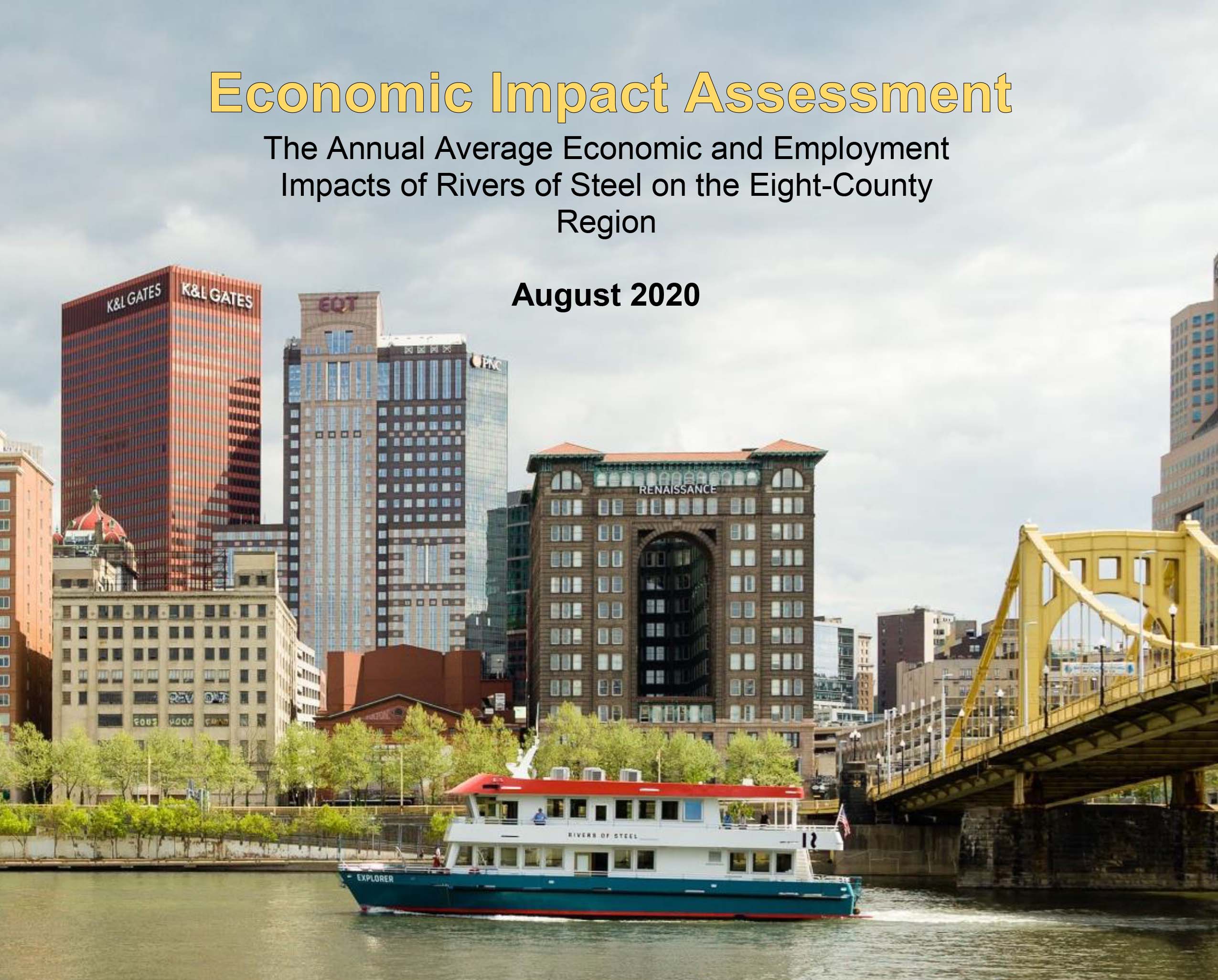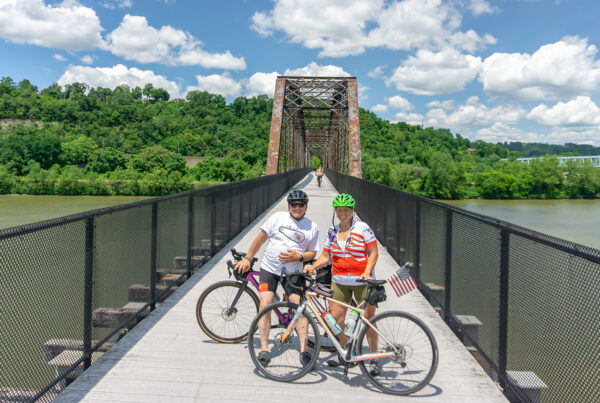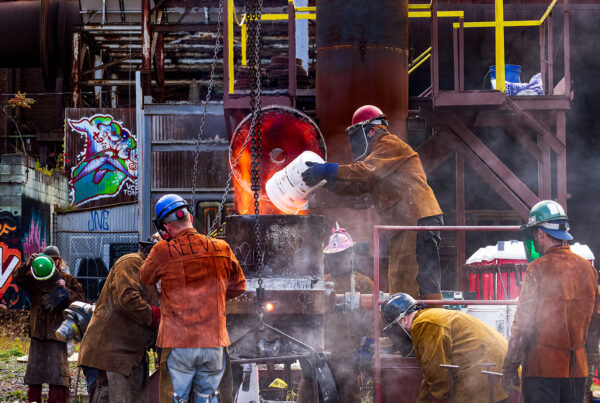
Rivers of Steel National Heritage Area Visitor Spending Generates Economic Impact of $92 Million Annually
Homestead, PA (August 18, 2020)—Rivers of Steel released an economic impact study today that estimates the generation of more than $92 million of economic benefit and 922 jobs each year as a result of spending by visitors to Rivers of Steel and its partners, including the expenditures of Rivers of Steel on grantmaking, operations, and capital improvements.
- More than 25,000 individuals visit Rivers of Steel’s sites each year to participate in more than 50 experiences, attractions, and programs.
- More than one million individuals visit sites and programs operated by close partners throughout the Rivers of Steel National Heritage Area region who have significant ties to Rivers of Steel and to the history and heritage they collectively showcase.
- Together with its close partners, this assessment estimates that Rivers of Steel influences or helps to attract more than 400,000 visitors to the region on average each year.
- Between 2016 and 2018, Rivers of Steel awarded an average of more than $71,000 in mini-grants per year awarded to its partners – regional nonprofits and municipal governments for heritage-related projects.
- Throughout its 25-year history and especially over the past seven years, Rivers of Steel has invested in its built environment, creating or renovating historic sites, National Historic Landmarks, and various facilities under its control. On average, Rivers of Steel spends approximately $176,000 on construction each year, contributing to capital expenses.
- The annual average of direct, indirect, and induced economic impact estimates a $92 million return on the annual investment of $664,000 by the National Park Service through the National Heritage Area program and an average investment of $200,000 by the Pennsylvania Department of Conservation and Natural Resources through the Heritage Parks Program. The result is more than a 100-fold return on investment in terms of ultimate economic benefit for the eight-county region.
- In addition, all these activities and the resulting ripple effect in the economy generate significant estimated tax revenue for municipal, county, and state governments totaling more than $5.6 million and for the federal government of more than $7.4 million.
August Carlino, President and CEO of Rivers of Steel, said, “The unstated conclusion of this report proves that heritage tourism, and the National Heritage Area program of the National Park Service, along with the State Heritage Area program of the Commonwealth of Pennsylvania, are true economic drivers and worthy of the investments of the public and private sectors.”
“We have to remember,” Carlino continued, “that old, historic buildings can become economic booms to communities if there is a commitment to invest. Once they are gone, the unique character of a place changes forever. We not only lose the building, but we also contribute to the loss of our identity. Heritage Areas not only support jobs and generate revenue, but they also invest in these other intangibles that are so critical to the quality of life of the places we call our home.”
Today, Rivers of Steel operates a portfolio of historically-significant sites in the Monongahela River Valley, including the renowned Carrie Blast Furnaces National Historic Landmark in Rankin and Swissvale, along with the Bost Building National Historic Landmark—a museum and visitors center in Homestead, and the historic Pump House and Water Tower in Munhall, in addition to the W.A. Young & Sons Foundry and Machine Shop—another National Historic Landmark located in Rices Landing, Greene County.
Support for Rivers of Steel from Elected Officials
Recognizing the value of the annual investment from the National Park Service, several elected federal officials voiced their bi-partisan support for Rivers of Steel in response to this newly released assessment.
From U.S. Senator Bob Casey:
“The Rivers of Steel National Heritage Area has proven to be a cost-effective model for leveraging federal funds and private-public partnerships to stimulate local economies, increase tourism and promote education and conservation in Southwestern Pennsylvania,” said Senator Casey. “That is why it is critical for Congress to pass my legislation, the Pennsylvania National Heritage Areas Act (S.4009), which would extend Rivers of Steel’s authorization for 15 years, ensuring the preservation of Pennsylvania’s cultural sites for many years to come.”
From U.S. Congressman Mike Doyle:
“This report shows that the Rivers of Steel National Heritage Area is making an important contribution to our region’s economy in addition to the contribution it makes to our culture by preserving Pittsburgh’s remarkable history,” Congressman Doyle said. “It demonstrates the economic benefits that investments in historic preservation can produce.”
From U.S. Congressman Guy Reschenthaler:
“The Rivers of Steel National Heritage Area celebrates southwestern Pennsylvania’s historic steel legacy while generating tens of millions of dollars in economic benefits and hundreds of jobs for our region,” said Reschenthaler. “Importantly, the National Heritage Area (NHA) program is incredibly cost-effective, with every federal dollar matched with an average $5.50 in other public and private funding. I support Rivers of Steel and the NHA program, which will boost tourism and help facilitate a strong economic recovery for communities in southwestern Pennsylvania.”
Additionally, Rivers of Steel’s funding from the Pennsylvania Department of Conservation and Natural Resources is supported on the state level as well, as demonstrated here by Pennsylvania State Senator Jay Costa.
“Rivers of Steel’s portfolio of historic sites is one of the many treasures that make our region a destination for tourism and a desirable place to live year round,” said Senator Costa. “ I’m not surprised to see such a large economic impact associated with their activity and would encourage anyone who has not yet visited their historic sites to take advantage of the outstanding adventure they offer.”
Rivers of Steel also operates one 21st-century attraction—the Explorer riverboat, docked on Ohio River along Pittsburgh’s North Shore. Explorer, the world’s first LEED-constructed commercial passenger marine vessel. Explorer is a STEM education boat – the culmination of Rivers of Steel’s long-standing goal of connecting the region’s waterways to history – that offers unparalleled opportunities to experience the beauty of Pittsburgh and southwestern Pennsylvania from its rivers that once served as critical arteries for the steel industry.
Through its historical and 21st-century attractions, Rivers of Steel showcases the artistry and innovation of Pittsburgh and southwestern Pennsylvania’s industrial and cultural heritage―offering unique experiences via tours, workshops, exhibitions, festivals, and more. Behind the scenes, Rivers of Steel supports economic revitalization—working at the grassroots level to deepen community partnerships, promote heritage tourism, and preserve local recreational and cultural resources for future generations.
This assessment, conducted by The Hill Group, is a follow-up to an initial economic impact study examining the period of 1996-2012 that was conducted by the National Park Service and released in 2013. The new economic impact assessment serves as an assessment of annual average impact incorporating the evolution of experiences, attractions, programs, and partnerships developed since the last report and through 2019.
Rivers of Steel took a conservative approach to this study, careful not to present figures that may be difficult to defend or justify. It is an estimate of the economic impacts of history and heritage activities that are within the span of control or influence of Rivers of Steel Heritage Corporation. The economic impact results presented in this report are annual averages, not cumulative impacts for Rivers of Steel’s activity.
The full report is available here.
About Rivers of Steel
Founded on the principles of heritage development, community partnership, and a reverence for the region’s natural and shared resources, Rivers of Steel strengthens the economic and cultural fabric of western Pennsylvania by fostering dynamic initiatives and transformative experiences.
Rivers of Steel showcases the artistry and innovation of our region’s industrial and cultural heritage through its historical and 21st-century attractions―offering unique experiences via tours, workshops, exhibitions, festivals, and more. Behind the scenes, Rivers of Steel supports economic revitalization—working at the grassroots level to deepen community partnerships, promote heritage tourism, and preserve local recreational and cultural resources for future generations.
About the Rivers of Steel National Heritage Area
This eight-county region is one of 55 National Heritage Areas designated by the U.S. Congress and one of 12 State Heritage Areas. A National Heritage Area is a place of national significance to America. For Rivers of Steel, Congress recognized the industrial and cultural heritage of southwestern Pennsylvania. Through a public-private partnership with the National Park Service and the Pennsylvania Department of Conservation and Natural Resources, Rivers of Steel supports heritage conservation, heritage tourism, and outdoor recreation as a means to foster economic redevelopment and enhance cultural engagement.
Contact Carly McCoy at 412.464.4020, ext. 243 or by emailing cmccoy@riversofsteel.com.
Rivers of Steel | The Bost Building, 623 East Eighth Avenue, Homestead PA 15120
riversofsteel.com
###







